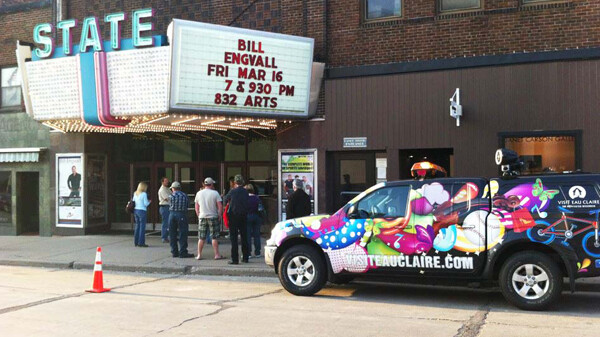Bringing It Downtown
Visit Eau Claire’s plans add to Confluence Project news

to base the Fun Patrol and the rest of its operations in the Confluence Project,
the proposed successor to the State Theatre.
Visit Eau Claire wants its headquarters to be part of the Confluence Project, and the tourism promotion agency is willing to make an investment to ensure the proposed performing arts center/mixed-use development succeeds.
The Visit Eau Claire board announced Dec. 18 that it’s willing to pay $50,000 annually to lease 5,000 square feet of space for an office and visitor center in the Confluence complex on South Barstow Street. In addition, once the performing arts center opens its doors, Visit Eau Claire has pledged to spend at least $25,000 per year for at least three years on a marketing campaign focused on the Confluence and events held there.
"We see the opportunity with the Confluence Project is to offer a visitor center presence that’s different than anything we’ve done in the past to serve pedestrian traffic.” – Linda John of Visit Eau Claire, on the agency’s planned relocation to the proposed Confluence Project in Eau Claire “We see the opportunity with the Confluence Project is to offer a visitor center presence that’s different than anything we’ve done in the past to serve pedestrian traffic,” said Linda John, executive director of Visit Eau Claire, which currently has its offices on Jeffers Road. “We believe there’s going to be a huge influx of people because of the Confluence and the university programming.” The downtown presence will add to the mobile visitors center and “Fun Patrol” efforts Visit Eau Claire has undertaken at community events in recent years, John said.
In a statement, Visit Eau Claire said it “enthusiastically supports” the Confluence Project, a roughly $80 million public-private proposal put forward by UW-Eau Claire, the Eau Claire Regional Arts County, and Commonweal Development. “The Confluence Project will foster the growth of our city and county through economic development, increased tax base, downtown revitalization, enhanced tourism, cultural/artistic investment, and advanced educational opportunities,” the group said. In addition to a multi-stage arts center jointly owned by UWEC and a nonprofit arts group, Confluence plans call for a privately owned mixed-use building that includes student housing.
Marketing the Confluence and its programs can draw visitors to the area, increasing room-tax collections and providing new funds to the city, John said. In addition, the funding commitment from Visit Eau Claire will help offset the arts center’s operating cost, she added.
COUNTY BOARD TO PONDER PROJECT
The Confluence Project’s success will depend on both private and public investment, and more of the latter may be coming in the near future. In January the Eau Claire County Board will consider a request for a $5 million investment in the performing arts center portion of the project. The request comes on the heels of the Eau Claire City Council’s Oct. 22 vote to make a similar $5 million pledge.
County Board Chairman Gregg Moore said the request will be taken up by the board’s Administration Committee on Jan. 7, the Finance Committee on Jan. 9, and likely the full board on Jan 21. If the County Board makes a pledge, it would only be to borrow money to go toward the arts center’s construction and not for its operation, Moore said.
“I think there’s a range of opinions on the board, from ‘Yes this makes sense to support the request’ to ‘No, philosophically this isn’t something the county should do,’ ” Moore said. In addition, some board members are likely be willing to make a pledge, but for a smaller amount.
For his part, Moore supports committing $5 million, though he expects a divided vote. While some people may view the Confluence as benefiting only the city of Eau Claire, not the county at large, Moore said he believes the project will boost sales tax receipts, which would help everyone in the county. In addition, he said, the city and county are economically interdependent: “A vibrant city of Eau Claire is critically important to the rest of Eau Claire County.”
Dan Clumpner of Commonweal Development, the private firm involved in the project, agreed that the project’s economic development potential will be crucial to the discussion with the County Board. If the Confluence partners are successful at the county level, their next step is to pursue funding from the state. “A strong commitment from local government is important as we pursue our discussions with the (UW System) Board of Regents and the (Walker administration’s) Department of Administration,” he said.
LANDMARK STATUS DENIED
Meanwhile, a recent City Council decision clears the way for the demolition of one of the buildings that now occupies the proposed Confluence site. On Dec. 10 the City Council voted 6-5 to strip the former Kline Department Store, 6 S. Barstow St., of the historic designation it received from the city Landmarks Commission in October.
After the Landmarks Commission voted to name the vacant, 1925 building a city landmark, the owners – Jerry and Lois Heymans of Winona, Minn. – filed an appeal, saying the designation impeded their ability to sell the property.
Had the council vote gone the other way, the historic landmark label “would require up to 18 months of discussion between developers and the Landmarks Commission before (the) building could be demolished,” the Leader-Telegram reported. Advocates for the building said its history and architecture made it worth preserving, while others argued that it was in such poor shape that saving it was unrealistic.




















